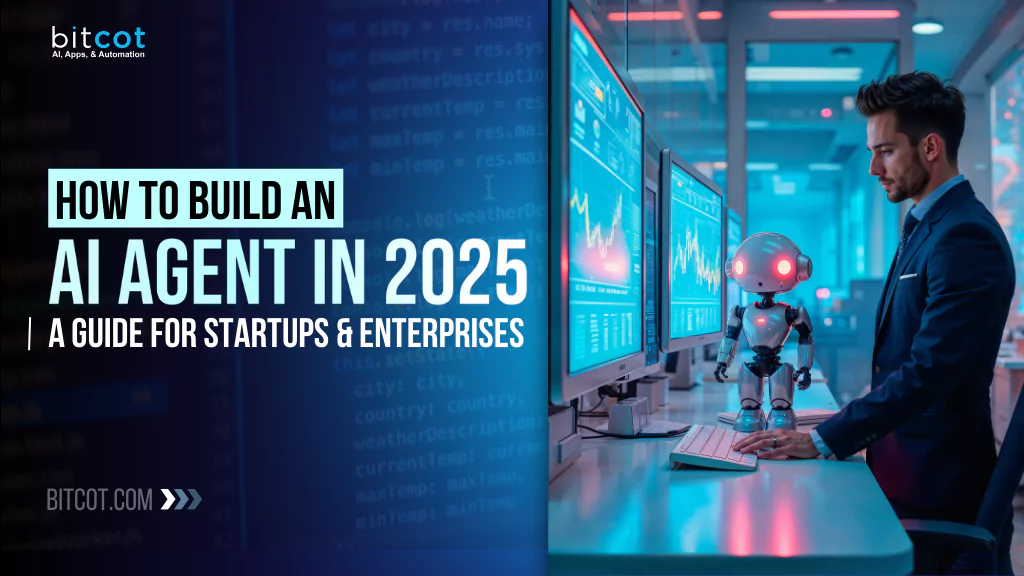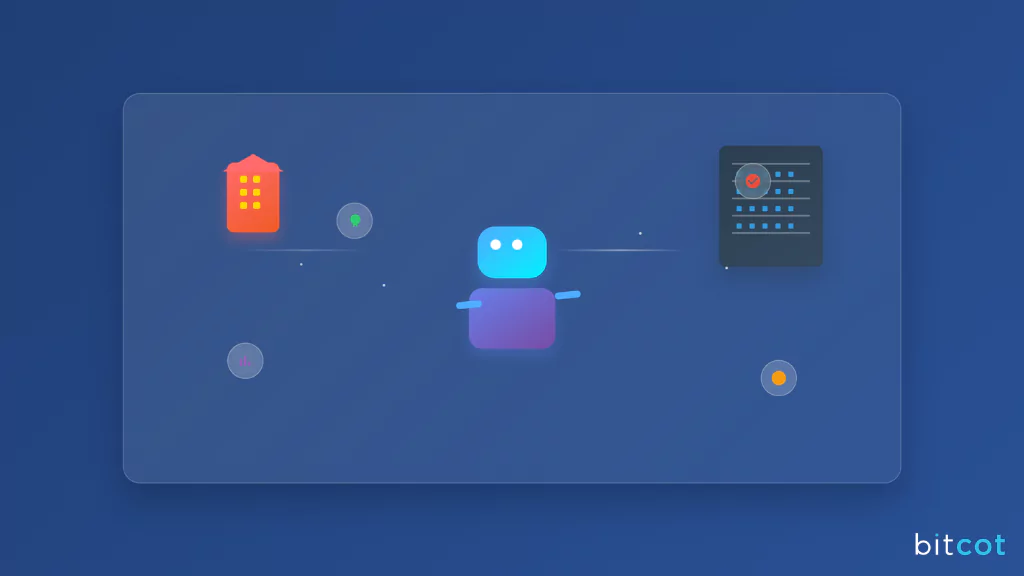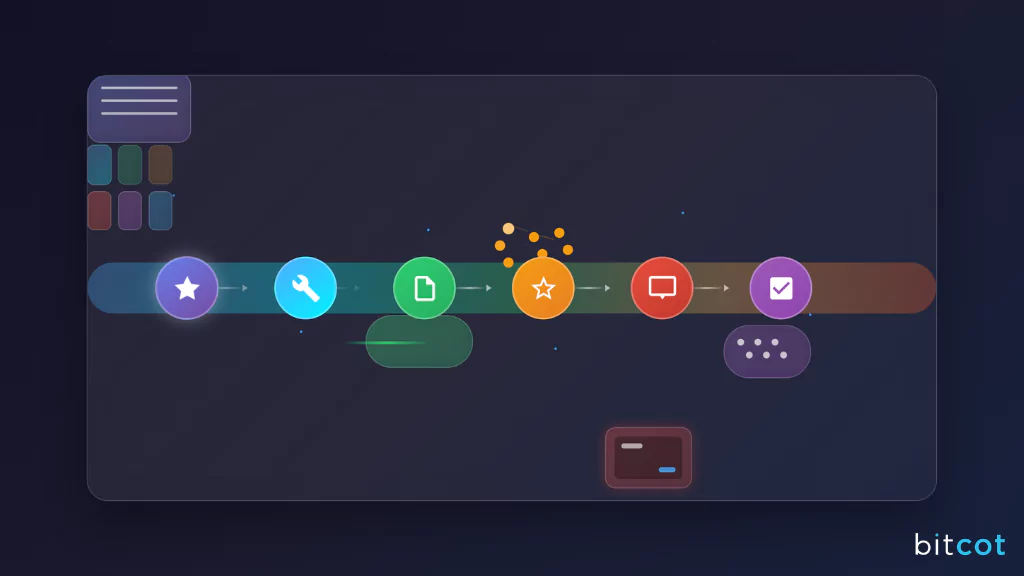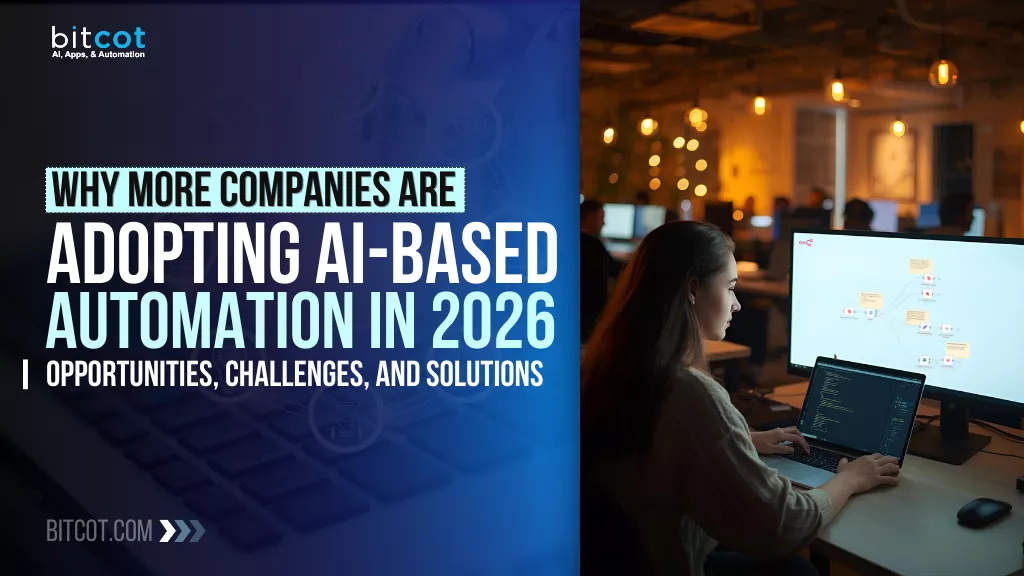
A decade ago, building a digital assistant seemed like something reserved for big tech companies with vast resources.
Fast forward to 2025, and AI agents aren’t just for the corporate giants; they’ve become indispensable tools for startups and enterprises alike. Today, these smart systems can manage everything from customer support to data analysis, streamlining workflows and optimizing decision-making in ways we couldn’t have imagined just a few years ago.
For startups and enterprises, building an AI agent is no longer just about integrating machine learning; it’s about understanding how to design, deploy, and scale these systems to meet specific business goals.
So, how do you build an AI agent that’s not only efficient but also aligned with the needs of your business?
Whether you’re looking to create an intelligent assistant to streamline operations or a decision-making agent that optimizes business processes, this guide provides the essential steps and considerations for developing cutting-edge AI agents.
We’ll walk you through the process, from understanding the core technologies involved to overcoming key challenges and leveraging the best tools available in 2025.
Let’s dive in.
What is an AI Agent?

Source: McKinsey & Company
An AI agent is a software entity designed to perform tasks autonomously by perceiving its environment, reasoning through data, making decisions, and acting on those decisions without constant human intervention.
Unlike traditional software, AI agents are powered by advanced machine learning models, natural language processing (NLP), and decision-making algorithms, which allow them to interact intelligently with users and systems.
At the core of every AI agent is its ability to process information, learn from interactions, and adapt to new data. This makes AI agents capable of handling a variety of tasks, such as customer support, predictive analytics, content generation, or even autonomous driving.
There are different types of AI agents, ranging from simple rule-based systems to more complex models using deep learning. Some are designed for specific purposes, like chatbots or virtual assistants, while others may function as part of larger systems, such as smart supply chains or decision-making frameworks in enterprises.
The key distinction between an AI agent and traditional software is autonomy: AI agents are designed not only to perform predefined tasks but also to improve their performance over time through feedback loops and continuous learning.
Why Should Startups and Enterprises Build AI Agents?

Building AI agents offers transformative benefits for both startups and enterprises, enabling businesses to scale efficiently, improve customer experiences, and drive innovation.
Here’s why integrating AI agents into your organization is a game-changer:
Enhanced Efficiency and Automation
AI agents can automate routine tasks, reducing the workload on human employees and freeing them to focus on higher-value activities. Whether it’s managing customer inquiries, processing data, or automating decision-making, AI agents help streamline operations and boost productivity.
This leads to faster response times, improved service delivery, and significant cost savings for businesses of all sizes.
Scalable Customer Support
For startups, customer support can be a challenge as your business grows. AI agents, such as chatbots or virtual assistants, can handle a high volume of inquiries simultaneously, offering instant responses at any time of the day.
This allows startups to scale their customer support operations without the need for a large team, ensuring customers receive the attention they need when they need it.
Data-Driven Insights
AI agents can analyze large volumes of data, uncover trends, and generate insights that might be overlooked by humans.
For enterprises, this means better decision-making, personalized customer experiences, and optimized business processes. AI agents can sift through mountains of data in real-time, offering predictions, recommendations, and tailored solutions that align with business goals.
Personalized User Experiences
AI agents are excellent at learning from user interactions and tailoring responses or actions based on individual preferences.
For both startups and enterprises, this means creating hyper-personalized experiences that delight customers, increase engagement, and foster loyalty. Whether it’s recommending products, assisting with complex queries, or predicting user needs, AI agents ensure that each interaction feels unique and relevant.
Competitive Advantage
Adopting AI agents gives businesses a competitive edge. Startups can differentiate themselves by offering cutting-edge AI-powered solutions from day one, while enterprises can stay ahead of the curve by integrating AI into their legacy systems.
By leveraging AI, companies can innovate faster, optimize their workflows, and respond to market shifts more effectively.
Cost Savings
Building AI agents can significantly reduce operational costs in the long run. AI agents can take over repetitive and time-consuming tasks, reducing the need for large teams and minimizing human error. For enterprises, this can lead to major savings in customer service, sales, marketing, and even R&D.
Whether you’re a startup looking to scale or an enterprise aiming to innovate, building AI agents is a powerful step toward future-proofing your business.
Key Technologies for Building AI Agents in 2025
To build powerful and scalable AI agents in 2025, businesses can choose from a mix of low-code platforms for rapid deployment, complex tools for advanced functionality, and AI models for smart, data-driven decision-making.
Here’s a breakdown of each category:
Low-Code Tools for Rapid AI Agent Development
Low-code platforms make it easier for businesses, especially startups or teams with limited technical resources, to quickly build and deploy AI agents. These platforms allow for customization while streamlining the development process.
- Copilot Studio: Ideal for businesses that need to quickly create AI agents without extensive coding, Copilot Studio simplifies the integration of automation workflows, helping you get AI solutions up and running fast.
- Power Platform: A powerful suite by Microsoft that enables businesses to automate workflows, build apps, and integrate AI functionalities with minimal code. It’s especially valuable for companies already within the Microsoft ecosystem.
- n8n: This open-source workflow automation tool is perfect for businesses that want to integrate various services and APIs to create customized AI processes. It’s particularly useful for automating tasks and connecting disparate systems.
- Botpress: A flexible platform specifically for building conversational AI agents like chatbots. Botpress enables businesses to design sophisticated customer support agents with advanced conversational abilities and integrations.
- Flowise: Similar to n8n, Flowise lets businesses create AI-driven workflows by connecting different AI tools, APIs, and databases, allowing rapid deployment while ensuring functionality across multiple services.
Complex Tools for Advanced AI Agent Solutions
For businesses that need more customized, sophisticated solutions, complex tools allow for greater flexibility and scalability in AI agent development. These tools cater to businesses with more advanced needs that require deep integration and real-time processing capabilities.
- LangGraph: A powerful tool for building graph-based conversational AI agents. LangGraph is ideal for businesses that need intelligent agents capable of processing complex, structured data and engaging in nuanced conversations across various topics.
- CrewAI: A platform for creating intelligent virtual assistants that can manage multiple tasks simultaneously. CrewAI is used for building agents that need to interact with multiple systems and adapt based on user inputs, such as in dynamic customer support or employee task management.
- Phidata: This tool helps businesses build AI agents that can handle big data analytics. Phidata is used for creating agents that analyze and process large datasets, providing valuable insights for data-driven decision-making.
- AWS Bedrock: A fully managed service for building and deploying enterprise-scale AI agents. AWS Bedrock provides the infrastructure and tools necessary for building large-scale, high-performance AI models that can process vast amounts of data and perform complex tasks.
Powerful AI Models for Decision-Making and Interaction
The intelligence of your AI agent is driven by the underlying AI models. These models enable the agent to understand data, interact with users, and perform tasks intelligently. In 2025, these models are more advanced and capable of handling complex queries and making informed decisions.
- GPT-4 & GPT-3.5-turbo: These advanced language models from OpenAI power conversational AI agents, enabling them to understand natural language and generate human-like responses. Ideal for applications like customer support, content generation, and personal assistants.
- Claude: Developed by Anthropic, Claude is focused on safe and ethical decision-making. It excels in industries like finance and healthcare, where decision-making must adhere to high standards of reliability and fairness.
- Gemini: Google’s advanced AI model, Gemini, is designed to provide high-level reasoning and decision-making capabilities. It’s used for applications where complex problem-solving and real-time analysis of large datasets are required.
- LLaMA: Meta’s open-weight model is used for specialized AI agents in industries that require deep expertise. LLaMA allows businesses to create highly custom AI agents, from technical support bots to industry-specific knowledge extraction tools.
Cloud Computing for Scalable AI Agent Operations
For AI agents to operate efficiently and scale as needed, businesses rely on cloud computing infrastructure. Cloud platforms provide the computational power necessary for building, training, and deploying AI models, enabling high performance and seamless scalability.
- Cloud Platforms (AWS, GCP, Azure): These platforms offer vast computational resources for training AI models and managing large-scale AI deployments. Services like AWS Sagemaker, Google AI, and Azure AI provide ready-to-use AI tools, model training environments, and scalable infrastructure that allow businesses to build, test, and deploy AI agents effectively.
- AI-as-a-Service: Many cloud platforms offer AI-powered services, such as natural language processing, computer vision, and machine learning, that can be integrated directly into AI agents. This reduces the need for in-house model training and accelerates the deployment process.
Data Management and Integration for Streamlined Operations
AI agents are only as good as the data they are trained on and interact with. For real-world applications, having strong data management, cleaning, and integration tools is key to ensuring data flows seamlessly into AI models for optimal performance.
- ETL Tools (Extract, Transform, Load): Tools like Apache Kafka, Apache NiFi, and Talend help integrate and manage the data streams that AI agents rely on. These systems pull data from various sources, transform it into useful formats, and load it into systems that AI models can use.
- Data Lakes and Warehouses (Snowflake, AWS Redshift): For enterprises with vast amounts of data, data lakes and warehouses are used to store and process unstructured data, making it accessible for AI models and machine learning pipelines.
AI Agent Evaluation Tools for Monitoring Performance
Once an AI agent is deployed, continuous evaluation is essential to ensure it performs optimally and evolves over time. These evaluation tools help businesses monitor, assess, and refine their AI agents based on real-world performance and user interactions.
- LangSmith: A tool for testing and monitoring language model-based agents. It helps track agent behavior, errors, and response quality in real-time, making it ideal for improving conversational AI and language processing agents.
- RagaAI: A tool for evaluating AI-driven content generation and NLP models. It measures key metrics like accuracy, relevance, and content coherence, making it perfect for businesses relying on content creation or chatbots.
- Langfuse: Focuses on monitoring LLMs in production environments. It tracks real-time interactions, logs errors, and provides feedback to improve the quality of agent responses, making it essential for businesses with real-time AI applications.
- MLFlow: An open-source platform for managing the machine learning lifecycle. It tracks experiment parameters, metrics, and model performance, enabling continuous evaluation and refinement of AI models during development and deployment.
- PareaAI: Designed for evaluating and optimizing conversational AI agents like virtual assistants and chatbots. It monitors interaction quality and helps businesses enhance the overall effectiveness of their AI-driven conversations.
How to Build an AI Agent in 2025: Step-by-Step Guide

Building an AI agent in 2025 is a multifaceted process that involves careful planning, choosing the right technologies, and ensuring a seamless integration of data, models, and user interfaces.
The journey can be broken down into several critical steps, each focused on achieving a functional, scalable, and effective AI solution.
1. Define the Purpose and Scope of the AI Agent
The first and most important step is to define what the AI agent will accomplish. This decision will inform every subsequent step, including which technologies to use and how to train the AI.
- Identify Use Cases: Determine the specific business problem you want the AI agent to solve. Is it for customer support (e.g., chatbots), task automation (e.g., process workflows), data analysis (e.g., predictive models), or something else?
- Set Clear Objectives: Establish measurable outcomes to track the AI agent’s success. For instance, do you want to improve customer service response times, automate routine tasks, or enhance decision-making accuracy?
- Consider Industry-Specific Needs: Tailor the agent to meet the unique needs of your industry, whether it’s healthcare, finance, eCommerce, or another field.
2. Choose the Right Tools and Technologies
The tools and technologies you choose will directly impact how quickly and efficiently you can develop the AI agent. The right platform depends on your needs, from low-code solutions to more sophisticated custom AI development.
- Low-Code Platforms: If you’re aiming for speed and simplicity, tools like Copilot Studio, Power Platform, and n8n are ideal. These platforms let you build and deploy AI agents without deep coding expertise, speeding up prototyping and reducing development costs.
- Complex Tools: For more specialized, customized solutions, use tools like LangGraph (for graph-based models), CrewAI (for multi-agent systems), and AWS Bedrock (for scalable enterprise-level applications). These tools are best for businesses that require specific functionality or highly-tailored AI agents.
- AI Models: Choose models that align with your use case. Pre-trained models like GPT-4, Claude, and LLaMA are ideal for natural language tasks, while other models may be more suited for specific needs such as image recognition or decision-making.
3. Data Collection and Preparation
Data is the lifeblood of any AI agent. Inadequate or poor-quality data will severely limit the agent’s performance. The data you use should be relevant, well-structured, and comprehensive.
- Gathering Data: Collect structured or unstructured data related to the problem your agent is solving. This could include historical customer service conversations, transactional data, documents, or sensor data.
- Data Cleaning: Raw data is often noisy or incomplete, so cleaning is critical. Remove duplicates, handle missing values, and filter out irrelevant data. This ensures that the model will learn from high-quality, accurate information.
- Data Annotation: For supervised learning, data needs to be labeled or annotated. For example, if you are building a chatbot, label each dialogue exchange to teach the model how to recognize different intents and responses.
- Data Augmentation: If you lack sufficient data, consider synthetic data generation techniques or use data augmentation methods like paraphrasing, noise addition, or translation to create more diverse data.
4. Develop and Train the AI Model
Once the data is ready, it’s time to develop and train the AI model that will power your agent. This step involves choosing between using pre-trained models or building custom ones from scratch.
- Pre-trained Models vs. Custom Models:
- Pre-trained Models: If you’re looking for efficiency and less time spent on model development, pre-trained models like GPT-4 or Claude can be fine-tuned for specific use cases. Fine-tuning allows the model to better understand your data and perform the required task more effectively.
- Custom Models: If your application requires a unique model (e.g., specific to your industry or use case), you might need to build a custom model. This could involve using deep learning techniques such as neural networks or reinforcement learning, which may require more computing resources.
- Training the Model: Use platforms like TensorFlow, PyTorch, or AWS Sagemaker to train your AI model. Monitor performance using MLFlow or TensorBoard to track metrics like accuracy, loss, and precision.
- Evaluation: After training, evaluate the model’s performance using a separate test set of data. Metrics such as precision, recall, F1 score, and AUC will give you insights into the model’s effectiveness and where it might need improvement.
5. Build the User Interface (UI)
The user interface is where users will interact with the AI agent. It must be intuitive, user-friendly, and fit the use case of the AI agent.
- For Chatbots: Platforms like Botpress or Flowise are ideal for building conversational UIs. Design conversational flows that feel natural, with clear intents and actions for the AI to perform.
- For Data-Driven Agents: If the AI agent is focused on analytics or decision support, build custom dashboards that provide real-time insights. Tools like Power BI or Tableau integrate well with AI agents and present data visually.
- For Multimodal Agents: If the agent involves more than just text (e.g., voice, images), make sure the UI is built to handle these interactions. Integrating voice recognition APIs or using computer vision might be necessary for such applications.
6. Integrate with Existing Systems
Most AI agents need to work within an existing technological ecosystem. Whether it’s connecting with databases, CRMs, or external APIs, integration is a crucial step for AI success.
- APIs and Webhooks: Use APIs to integrate your agent with other systems in your organization (e.g., integrating a customer service chatbot with your CRM system to fetch user data). This ensures your agent can provide personalized responses based on real-time information.
- Automation: Leverage tools like n8n or Power Platform for workflow automation. These tools can trigger tasks based on AI agent decisions, such as sending notifications or updating records in a database.
7. Test the AI Agent
Testing ensures that the agent functions as expected and meets its performance benchmarks.
- Alpha and Beta Testing: Start testing with internal teams (alpha testing) and then expand to a small group of users (beta testing). This helps uncover bugs, identify issues with the user interface, and gauge the agent’s performance.
- Scenario Testing: Test the agent in multiple scenarios, including edge cases or unexpected inputs, to ensure it handles real-world use cases effectively.
- Performance Metrics: Measure the AI agent’s performance based on metrics such as response time, accuracy, error rates, and user satisfaction.
8. Deploy the AI Agent
Once the agent passes testing, it’s time for deployment. You’ll need to choose a hosting solution that scales with your needs.
- Cloud Hosting: Leverage cloud platforms like AWS, Google Cloud, or Azure to deploy your AI agent. These platforms offer scalable infrastructure and powerful compute resources for running AI models.
- Containerization: Use Docker or Kubernetes to containerize the AI agent and deploy it across multiple servers efficiently.
- Load Balancing: Ensure that the agent can handle large volumes of requests by using load balancers, which will distribute the workload across multiple instances of the agent.
9. Monitor and Optimize
Once the agent is live, continuous monitoring and optimization are essential to ensure long-term success.
- Real-Time Monitoring: Use tools like Prometheus and Grafana to monitor your agent’s performance in real-time. Track metrics such as response time, error rates, and system health.
- Agent Evaluation: Use platforms like LangSmith, RagaAI, and Langfuse to monitor agent behavior, measure content quality, and assess real-time performance. These tools help identify areas for improvement and optimize agent responses.
- User Feedback: Collect feedback from users to identify any issues, such as confusion or frustration, that may arise during interactions. Use sentiment analysis tools to evaluate customer satisfaction.
- Continuous Improvement: As your AI agent interacts with more users, use this data to retrain the model, improve its responses, and optimize its algorithms for better performance.
Partner with Bitcot to Build Advanced AI Agents
At Bitcot, we specialize in creating highly intelligent, scalable, and customized AI agents designed to solve your unique business challenges. Whether you’re a startup or an enterprise, partnering with us will ensure that your AI solutions are tailored to meet your exact needs, powered by the latest in AI technologies.
Expertise in Advanced AI Development
Bitcot leverages both low-code and complex AI development platforms to build flexible and scalable AI agents. We use tools like Copilot Studio, Power Platform, and n8n for rapid prototyping and deployment, as well as more specialized tools like LangGraph, CrewAI, and AWS Bedrock for custom, high-performance AI solutions.
- Low-Code Platforms: These tools allow us to quickly build and deploy functional AI agents, enabling you to get to market faster while keeping costs low.
- Complex AI Tools: For more tailored solutions, we use sophisticated technologies to build intelligent agents capable of handling complex tasks, integrating with enterprise systems, and scaling as your business grows.
Tailored AI Solutions to Meet Your Business Needs
At Bitcot, we provide custom AI solutions designed to enhance various aspects of your business. Our AI agents are flexible and can be tailored to improve key business functions, driving efficiency, innovation, and growth. Here are five key areas where AI can make a significant impact:
- Customer Engagement: Improve how you connect with your customers, providing personalized, responsive, and efficient interactions through intelligent AI agents.
- Process Automation: Streamline and automate internal processes, reducing manual effort and increasing operational efficiency across your organization.
- Data Analysis and Decision Support: Use AI to process and analyze data, uncovering valuable insights that support better business decisions and strategic planning.
- Workflow Optimization: Enhance productivity by optimizing workflows and improving collaboration between different teams and systems through intelligent automation.
- Scalability and Flexibility: Build AI systems that scale as your business grows, allowing you to quickly adapt to changing market needs and demands without compromising performance.
Seamless Integration with Your Existing Systems
One of the most important aspects of building AI agents is ensuring they work seamlessly with your existing infrastructure. Bitcot specializes in integrating AI agents with your CRM, ERP, databases, or any other internal system, ensuring smooth data flow and consistency across platforms.
- Cloud Integration: We work with cloud platforms like AWS, Google Cloud, and Azure to deploy your AI agent at scale, ensuring it can handle large volumes of data while maintaining high availability and reliability.
- API Integrations: Whether it’s connecting to third-party applications or internal business tools, we ensure that your AI agent can integrate with existing systems through APIs, webhooks, and other data-sharing technologies.
Comprehensive End-to-End Support
From the initial concept through development and deployment, and all the way to ongoing optimization, Bitcot offers end-to-end support for building AI agents. We guide you through every stage of the process, ensuring that your solution meets your business needs and continues to improve over time.
- Custom Development: We handle everything from initial planning and architecture to development, testing, and deployment, making sure your AI agent is up to the highest standards of quality.
- Continuous Optimization: After deployment, we monitor your agent’s performance, gather feedback, and refine the model as needed, using tools like LangSmith, MLFlow, and PareaAI for continuous evaluation.
- Post-Launch Maintenance: We provide ongoing maintenance and support to ensure your AI agent evolves with your business. Whether you need to update features or retrain the model, we’ve got you covered.
Leverage Advanced AI Evaluation Tools
At Bitcot, we believe in continuous improvement. After your AI agent is deployed, we use advanced AI evaluation tools like Langfuse, RagaAI, and DeepEval to monitor and assess its performance. These tools allow us to fine-tune your agent, optimize responses, and improve its decision-making capabilities over time.
- Performance Tracking: We continuously track key metrics like accuracy, efficiency, and user satisfaction to ensure that your agent meets or exceeds performance expectations.
- Iterative Improvement: Using feedback from evaluation tools and user feedback, we make data-driven improvements to the agent, ensuring it evolves and adapts to changing business requirements.
Scalability and Flexibility
Bitcot’s AI agents are built to scale with your business. Whether you’re expanding your user base, introducing new features, or handling increased data loads, we ensure your AI agents are designed for growth.
- Elastic Scalability: Using cloud platforms like AWS Bedrock and Google Cloud, your AI agents can scale automatically based on demand, ensuring optimal performance even during peak traffic.
- Adaptable Architecture: We build AI systems that can grow with your business, making it easier to integrate new features, data sources, or systems as your business needs evolve.
Final Thoughts
Building and integrating AI agents into your business operations can unlock tremendous value, driving efficiency, innovation, and growth. As we move into 2025, AI technology continues to evolve, offering more powerful tools and solutions for businesses of all sizes.
Whether you’re looking to improve customer engagement, automate processes, or enhance decision-making, the right AI agent can make a significant difference.
At Bitcot, we understand that every business has unique needs, and that’s why we focus on custom AI agent development services that align with your specific goals. Our team of experts is ready to guide you through every stage of AI development, from planning and design to deployment and continuous optimization.
Partner with us to stay ahead of the curve and leverage AI to transform your business for the future.












